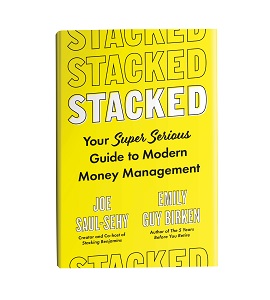
Stacked
If you’ve looked for a good book to help you manage your money better, I’m sure you’ve been overwhelmed by all of the possible options out there. The problem with most of these books is that they take a very serious approach to teaching you about money – after all, money is a serious matter, right? And being serious is not a very enjoyable place to be, so unfortunately working through many of the books available can be a real slog.
What if I told you that there’s another option out there, a book that will entertain you, even make you snicker, along with teaching you some very serious things about money?
Today I have the privilege of reviewing a new book by my friend Emily Guy Birken and her co-author, Joe Saul-Sehy. The book is entitled Stacked – Your Super Serious Guide to Modern Money Management. These two folks have taken on the monumental task of keeping you engaged, entertained, and learning all the way through their guide to a quite serious subject – and they’ve done an amazing job!
You might recognize the names – Emily has been writing in the personal finance space for many years now, and Joe has a very successful personal finance podcast, Stacking Benjamins. If you’ve spent any time at all searching through the internet for personal financial guidance, you’re sure to have come across one or the other (or both!) many times. As I understand it, this is the first time they’ve worked together, and they have done a wonderful job, in my opinion.
Throughout the book, you’ll find many new and interesting angles to consider each financial concept – and you’ll find a peppering of interesting factors as well. Who knew you could learn about money management alongside such diverse references as: Oregon Trail, Gordita Supremes, Thomas Jefferson (“stone-cold red headed Tommy Jeff”), Tetris, platform shoes with goldfish in the heels, Veruca Salt, MFs, a Snoopy Sno-Cone maker, beanie babies, a notorious tatoo, fine Michigan wine, as well as David Lee Roth and Brian Wilson (in the same paragraph, no less!).
You’ll also find out the answers to some burning questions that you didn’t even realize you needed to know, such as why you might need to call Sallie Mae “Ms. Mae”, why debt-payoff strategies are so snowy, and what makes a sleeping financial professional exclaim “Past performance is no guarantee of future results” without actually waking up.
Clearly this isn’t your typical money management book. But the lessons within are fantastic, and all of the wonderful sidebars and somewhat silly examples kept me entertained throughout.
Joe and Emily don’t do all of this alone, either. Sprinkled throughout the book are timely advice from Joe’s Mom, who is a surprisingly astute observer of all things financial. In addition, each chapter contains a transcript from the popular Stacking Benjamins podcast, from financial industry and personal finance luminaries such as Jean Chatzky, Paula Pant, David McKnight, Jill Schlesinger, and Farnoosh Torabi, to name a few. With these additions, you not only get Joe & Emily’s view of matters, but some of the finest minds in the personal finance space to boot.
All in, I thoroughly enjoyed reading this book. At 300+ pages, it was a surprisingly quick read, primarily due to the fun and irreverent ways the authors present these serious topics. I highly recommend this book for anyone who has been left cold by the current offerings of money management guides, as well as for anyone who could use another perspective to help them along the way to managing your money. I’ve been in this industry for, well let’s just say a long time, and I picked up a few gems myself!
Kudos, Emily and Joe!




















 Sterling Raskie, MSFS, CFP®, ChFC®
Sterling Raskie, MSFS, CFP®, ChFC® The latest in our Owner’s Manual series, A 401(k) Owner’s Manual, was published in January 2020 and is available on
The latest in our Owner’s Manual series, A 401(k) Owner’s Manual, was published in January 2020 and is available on  A Medicare Owner’s Manual, is updated with 2020 facts and figures. This manual is available on
A Medicare Owner’s Manual, is updated with 2020 facts and figures. This manual is available on  Social Security for the Suddenly Single can be found on Amazon at
Social Security for the Suddenly Single can be found on Amazon at  Sterling’s first book, Lose Weight Save Money, can be
Sterling’s first book, Lose Weight Save Money, can be  An IRA Owner’s Manual, 2nd Edition is available for purchase on Amazon. Click the link to choose the
An IRA Owner’s Manual, 2nd Edition is available for purchase on Amazon. Click the link to choose the  Jim’s book – A Social Security Owner’s Manual, is now available on Amazon. Click this link for the
Jim’s book – A Social Security Owner’s Manual, is now available on Amazon. Click this link for the  And if you’ve come here to learn about queuing waterfowl, I apologize for the confusion. You may want to discuss your question with Lester, my loyal watchduck and self-proclaimed “advisor’s advisor”.
And if you’ve come here to learn about queuing waterfowl, I apologize for the confusion. You may want to discuss your question with Lester, my loyal watchduck and self-proclaimed “advisor’s advisor”.